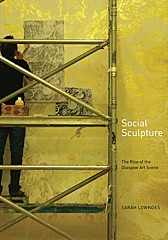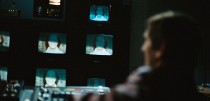Image: Front cover of Sarah Lowndes’ book Social Sculpture: The Rise of the Glasgow Art Scene
One of the closing events of this year’s Edinburgh International Book Festival saw visual artist Martin Boyce, curator Adam Szymczyk and author Sarah Lowndes discussing the factors that have contributed to the rise of the Glasgow arts scene since the 1970s. Lowndes is the author of Social Sculpture: The Rise of the Glasgow Art Scene which provided a basis for the discussion.
Central Station spoke to Martin Boyce before the event about his experiences of studying and working in the city. He was born in Hamilton and studied at Glasgow School of Art. His work includes sculpture and installation and is often inspired by modernist design and explores its role in a contemporary setting. He represented Scotland at the 53rd Biennale di Venezia in 2009 with his exhibition No Reflections.
Do you think there’s been a resurgence of interest in Glasgow’s recent cultural history?
I don’t think there’s a resurgence of interest but I think as the history has continued to accumulate there’s more and more evidence that it wasn’t just a burst of activity; it is an ongoing situation that continues to be incredibly strong and healthy. Now you can definitely say that the situation in Glasgow and the art production, culture and music really has solidified as an important centre and I think it continues to attract people into it rather than it just being something happening within it.
What do you think it is about Glasgow that has led to it being such a fertile ground for artists in recent years?
It’s difficult to know because I certainly, as an individual, didn’t feel as though I was at the forefront of saying ‘Come on let’s build a situation here’. There were more vocal people around me that would articulate that and then through being in that situation it allowed you to reflect and think yeah of course, this could be a good situation, a situation that we stay in rather than flee from.
For me Transmission Gallery was a very central thing because it was basically an HQ for people, even if you weren’t on the committee it was a gathering point. And I think that kind of thing was important, but that can be a bar or a café or somebody’s house, just a place that becomes a natural gathering point.
And you enjoyed your time at the Art School?
Yeah, it was all I’d wanted to do even though I probably didn’t even know what happened at Art School. Particularly Glasgow School of Art, I don’t know exactly for what reasons, I guess [because] I was brought up in Hamilton, just outside Glasgow, so it was just this sort of beacon of hope. I really thought it was going to be much wilder. I was a bit nervous, [thinking] ‘what if there’s going to be an orgy on the first day?!’ but of course it’s just a bunch of other people like you.
Were you inspired by the artists who went before you?
I don’t know if this happened in every other department but I was in environmental art and the way the studio was laid out… everyone mixed quite a lot. When I was in the first year I was part of the fashion show which used to be a bit less about fashion and [more] a big theatrical thing and I remember Douglas [Gordon] had some sort of performance and Roddy Buchanan and all those sorts of people so I think I met them then. So by the time [Gordon] was in fourth year and then left there was a bunch of people in different years who were all friends.
You were not influenced by their work necessarily, it was definitely people’s attitude, how they spoke about their plans for the future, what might be possible, what they wanted to do and their ambitions. There definitely were a few people whose level of, not ambition in as much as they wanted to be famous artists, but just that idea that it would naturally continue, it wasn’t that sense of ‘ok what do we do now?’ All of that seeps in and stays with you.
Is it different for graduates now?
I do think that with art schools there’s a funny thing where people who are a couple of years before you are really influential to other students, rather than other artists that are out there. I remember feeling that quite a bit and I see it when I’ve done some teaching at the art school, you do get this frustrated feeling that people’s levels of ambition are quite restricted. There are always one or two people who set their sights much further, way beyond what’s happening in the art school. It’s not about slotting into the success of someone 2 or 3 years ahead of you.
You’ve also spent time in Berlin, what was that experience like?
It was really fantastic, it just came at the right time I think. I’d always lived here [in Glasgow], I’d done an exchange in LA when I was studying in ’95 but apart from that I’d never really lived anywhere else so this opportunity came up and it seemed like a break. We put everything in storage and basically went to this new studio with virtually nothing.
Even at that time [2005] it was very popular with artists but in the last five years it’s transformed as well, so many artists and so many galleries have moved there so it’s kind of overloaded, it’s changed quite a lot. It really felt like it was still on the end of its glory period since the wall came down, a real city of possibility.
Did it give you a new perspective on Glasgow and working in the city?
There was definitely a sense of being able to view Glasgow from another viewpoint and looking at what had been built up and think about whether it’s still important to go back and be part of that.
There were lots of pros and cons, it’s just a very different city. And it’s different when it’s home. Berlin really felt like anything was possible because it’s really new to you. Also living in a city where I didn’t speak any German, you’re living in your own kind of bubble, socialising with other artists, so there was kind of a reality chunk that was missing which was very attractive for a short period of time.
Social Landscape: The Rise of the Glasgow Art Scene is out now in paperback and published by Luath Press Ltd.















Comments